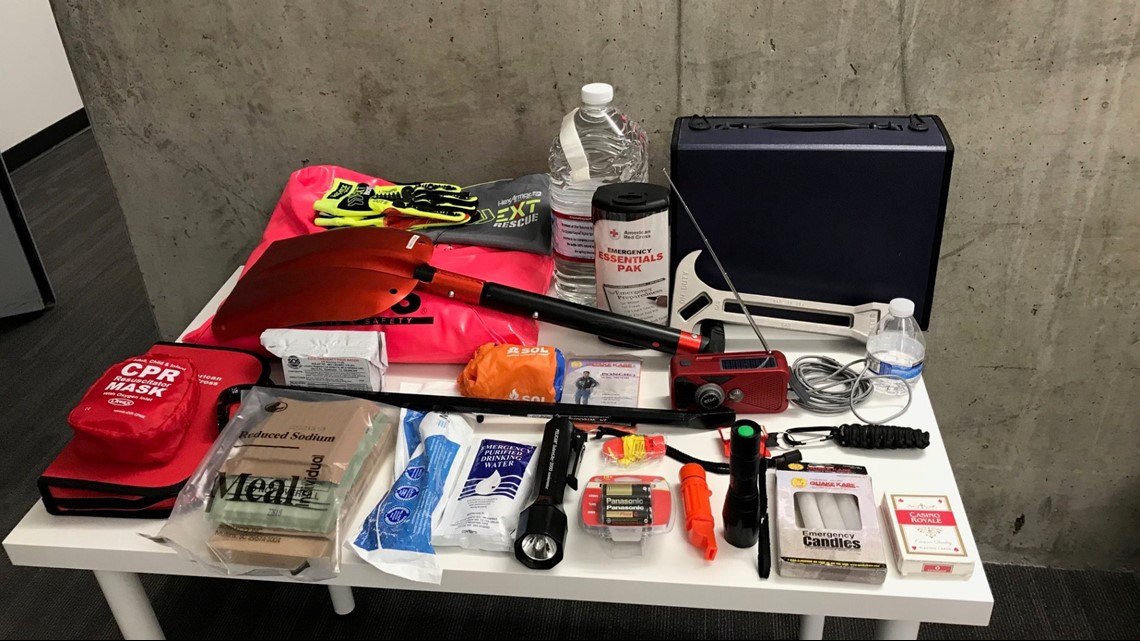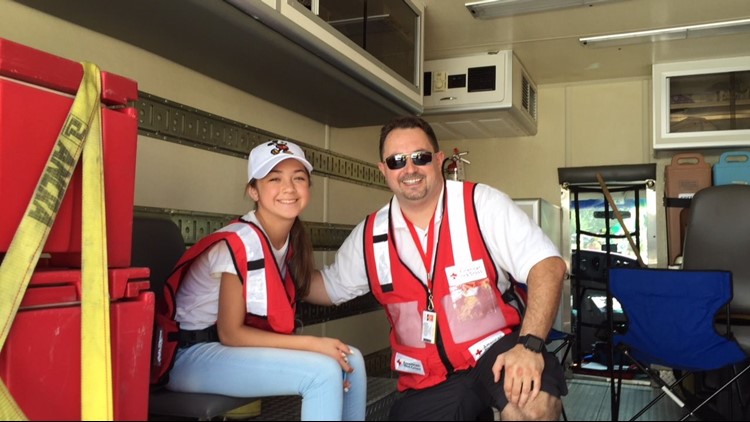Monty Burich is an American Red Cross volunteer and disaster preparedness expert. We sat down with him to find out why he volunteers and how he is emergency-ready.
*Scroll down for a list of disaster kit items and links*
What exactly do you do as a Red Cross Volunteer?
Well, my daughter Caitlin and I are disaster preparedness educators who teach communities and companies about preparing themselves, their families, their friends, or employees how to prepare for many different types of disasters both natural and man-made.
I am also trained as a Disaster Action Team (DAT) member who is trained to respond to disasters as well as support local Red Cross shelters during disasters. I also teach citizen CPR, which is a more simplified version of the full First Aid, CPR, AED class we offer at the American Red Cross. These are offered periodically for those who may not want to learn the entire complement of skills but would like to know some really basic stuff in the event that something happens.
There are so many things to do in the Red Cross. Areas that are in typically high demand are nurses and people who can speak different languages. But even if you don’t have those skills, there is probably something you will connect with as a volunteer within the team. Like radios? Come on down! Like Shelter Work? Come on down! Like data entry? Come on down! There is a little of something in the American Red Cross.
Volunteering doesn’t take all your available time, but if you want to donate a lot of time, you are welcome to. I work a 10-hour a day job during the day and allot a small amount of my time to the Red Cross. My daughter attends high school and is also a cheerleader-- her time is far and few, but we both commit to giving time to the Red Cross when we are able. So, for a working family, you can volunteer with a little planning and understanding.
Why are you so passionate about emergency preparedness?
In 2001, I lived in Spanaway, not far the epicenter of the Nisqually quake. When it struck, I was shocked at how little control over the situation I had. Everything was moving. After the event of 2001, I made a decision that some way, I wanted to find a way to prevent my kids from struggling in a disaster, and I wanted to help others learn also.
I joined a local Community Emergency Preparedness Team (CERT) in Kent. The CERT Class, which is still offered today in many cities, gave me the basic skills to be able to help people when police and fire may initially be tied up following an incident. Think of CERT as a citizen responder. While you do not gain the advanced training of our hard-working professional rescuers and law enforcement officials, you will know enough to be able to help your family and people in need. After I did all this, I gravitated to joining the American Red Cross.
My daughter Caitlin also wanted to join to be able to help. A lot of kids don’t understand there is a place for them at the American Red Cross if they want to volunteer.
Recently, I joined another organization that deals with situations such as these. It’s called the Civil Air Patrol. It’s an organization that is an auxiliary of the U.S. Air Force that deals with emergency services and search and rescues as well as many other missions. One of these missions deals with teaching cadets how to prepare and deal with situations such as disasters. The kids range from 12-18 whereafter they can become a senior member and join aerial search teams. It’s a great program for kids and adults who want to learn about how they can help.
If people are feeling overwhelmed about getting ready, what advice can you give them?
First step (Plan):
Slow down and take a deep breath, it’s a lot to take in! You don’t have to spend thousands of dollars today to be prepared. It starts with a meeting with your family or friends and planning about what they would do in a major event. How would we communicate? How would we survive on our own? Do we have enough supplies? Do we have the training? Once you have discussed and listed it, you can take action.
Second step (Prepare some kits):
After getting a plan together, now it’s time to gather supplies. You can go the American Red Cross website for a list of items you should have in your kits--yes, I said kits. Always have more than one. A small one for the car, a small one for the office, a large one at home, small kits for the kids' backpacks. Kits don’t have to be super elaborate, but they should contain the basics. You can buy a premade kit, but that will get you about 80% complete. You will need to add items such as medications, documents, comfort foods, toys, animal food, baby items, glasses, utensils, entertainment (playing cards, books, etc.)
Third step (Get some knowledge):
Get informed! Time to learn some good skills that can help. Learn First Aid, CPR, and how to use an AED. You can take a class through your local American Red Cross Chapter or utilize another service depending on where you live. If you are already first-aid trained, take a wilderness first aid training!
Next, sign up for a local CERT class if your area hosts one. You can find out information through your local fire department or emergency management office. You can also locate one through the FEMA.gov website.
Often these classes are free for residents or the fees are very inexpensive. You can get practical training like shutting off a gas line, carrying people out of a building, putting out small fires, triage, and light search and rescue. These are often taught by the people who respond to fires and emergencies on a daily basis.
When all else fails during an emergency... where do we go?
Connect with your neighbors (preferably well before the disaster occurs). See if they are willing to help you if your home becomes unlivable. If there is nowhere else to go, look for a local shelter. The American Red Cross will set up shelters throughout the area.
Places to look for shelters will be community centers, schools, public buildings, and some VFW halls. Bottom line--be as prepared as you can, but if you are truly needing help, shelters will be available soon after an event.
What is the one thing you want people to take away from your story?
Please, take some time to be prepared. Your family is counting on you to make it through a disaster, so do them the favor and honor that trust. It’s not always easy to talk about the potential for a life-altering disaster, but remember it’s too late to talk about planning once the disaster has occurred. For people on a budget, you can also do this. I, too, live on a tight budget, but one additional can of food, or a small tool, or even 2 extra bottles of water on each grocery shopping trip will help make all the difference. If you remember one statement from me, it’s that having some of a kit, is better than having no kit at all.


Name some items in your disaster kits:
Communication items:
* Emergency contact list including out-of-area and local contacts, doctor info, insurance info, and address.
* Phone charger cable and power supply for your phone
* Handheld battery-operated radio
* Spare batteries
* Hand crank radio with built-in phone charger capability
Optional
* Handheld CB radio
* HAM radio license and small HAM radio
* FRS Radios for family communication if separated short distances such as helping neighbors.
Food and water:
* Plastic utensils
* Napkins
* Salty sweet snack mixes
* MREs (Meals Ready to Eat)
* Dried Fruit or veggies snacks
* Granola bars
* Energy bars
* Candy for comfort
* water (Gallon per person per day is what we typically consume, so adjust as needed)
* Juice boxes (For kiddos)
* Baby bottles and formula (For little ones)
* Some water for the family pet.
Tools:
* First-aid Kit
* Fire Extinguisher
* Matches or fire starter and a few magazine or newspaper to use as kindling or reading material during an event.
* Paper Maps (City, State)
* Compass and instructions
* Small candles (Outdoor use only, do not burn them inside the car!)
* Jumper Cables
* Folding shovel
* Blankets
* Solar Blankets to help preserve body hear or reflect extreme heat
* Jackets and other warm water-resistant clothing and boots / Ponchos
* Flares
* Flashlight and batteries
* Inflated Spare tire or Inflator kit (Some cars no longer have spare tires)
* Duct Tape
* Car jack and tools
* Medium to Large tote with wheels if possible to lug around.
Vehicle:
* ½ tank minimum fuel in the cars gas tank
* Good wipers
* Regular oil changes and maintenance
Other items:



